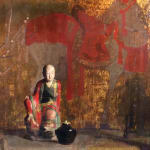Hovsep Pushman 1877-1966
The Prince and His Horse
Oil on canvas en grisaille
26 x 20 1/2 inches
66 x 52.1 cm
Framed dimensions 34 1/4 x 30 3/4 inches
66 x 52.1 cm
Framed dimensions 34 1/4 x 30 3/4 inches
Signed lower right: Pushman
Hovsep Pushman was one of those rare artists whose work was appreciated by both critics and collectors, and who enjoyed recognition and good fortune. In a 1932 one-man show at...
Hovsep Pushman was one of those rare artists whose work was appreciated by both critics and collectors, and who enjoyed recognition and good fortune. In a 1932 one-man show at New York's Grand Central Art Galleries, the entire display of sixteen paintings by Pushman was sold before opening day's end.
Pushman, later a naturalized American citizen, was born in Armenia in 1877. At age 11, he held a scholarship at the Constantinople Academy of Art. By 17, he had gone to the United States and started teaching art in Chicago. Pushman received his formal education in Paris at the Beaux-Arts Academie under Lefebvre, Robert-Fleury and Dechenaud. He exhibited his work at the Salon des Artistes Francais in Paris, winning a bronze medal in 1914 and a silver medal in 1921. He also was awarded the California Art Club's Ackerman prize in 1918.
Pushman's artistic identity began to take shape after he opened his own studio in 1921. Robert-Fleury, upon seeing one of Pushman's early studio still lifes, advised the artist, "That painting is you." Thereafter, Pushman's career was devoted to one subject, oriental mysticism, and one form, the still life. His paintings typically featured oriental idols, pottery and glassware, all glowing duskily as if illuminated by candlelight. They were symbolic, spiritual paintings, and were sometimes accompanied by readings, which helped to explain their allegorical significance. Most importantly, they were exquisitely beautiful, executed with technical precision.
Pushman, later a naturalized American citizen, was born in Armenia in 1877. At age 11, he held a scholarship at the Constantinople Academy of Art. By 17, he had gone to the United States and started teaching art in Chicago. Pushman received his formal education in Paris at the Beaux-Arts Academie under Lefebvre, Robert-Fleury and Dechenaud. He exhibited his work at the Salon des Artistes Francais in Paris, winning a bronze medal in 1914 and a silver medal in 1921. He also was awarded the California Art Club's Ackerman prize in 1918.
Pushman's artistic identity began to take shape after he opened his own studio in 1921. Robert-Fleury, upon seeing one of Pushman's early studio still lifes, advised the artist, "That painting is you." Thereafter, Pushman's career was devoted to one subject, oriental mysticism, and one form, the still life. His paintings typically featured oriental idols, pottery and glassware, all glowing duskily as if illuminated by candlelight. They were symbolic, spiritual paintings, and were sometimes accompanied by readings, which helped to explain their allegorical significance. Most importantly, they were exquisitely beautiful, executed with technical precision.
Provenance
Private collection, PennsylvaniaPlease join our mailing list
* denotes required fields
We will process the personal data you have supplied in accordance with our privacy policy (available on request). You can unsubscribe or change your preferences at any time by clicking the link in our emails.



